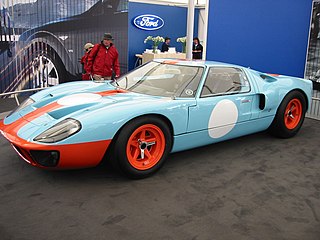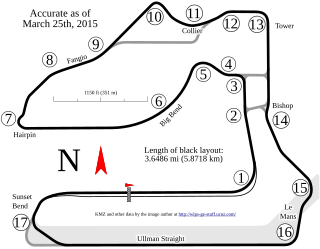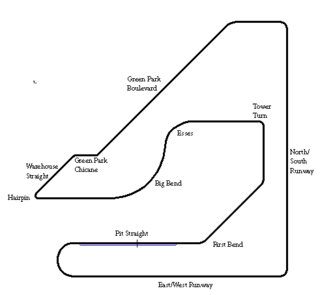
The Ford GT40 is a 1960s high-performance endurance racing car designed and built for and by the Ford Motor Company "Ford GT" project, an effort to compete in European long-distance sports car races, against Scuderia Ferrari, which had won the prestigious 24 Hours of Le Mans race from 1960 to 1965. Around 100 cars have been made, mostly as 4.7 litre "289" V8 mid-engined sportscars, some sold to private teams or as road legal Mk.III cars. Racing started in 1964, with Ford winning World Championships categories from 1966 to 1968. The first Le Mans 24h race win came in 1966 with two 7.0 litre "427" powered Mk.II prototypes crossing the finish line together, the second in 1967 by a 7.0 litre highly modified US-built Mk.IV "J-car" prototype. Considered too fast, a rule change from 1968 onwards limited prototypes to 3.0 litre Formula 1 engines, yet the private JW "Gulf" team collected additional Le Mans wins in 1968 and 1969 with the very same "old" Mk.I GT40 sportscar, still allowed with up to 5.0 litre engines when at least 25 had been made.

The Porsche 904 is an automobile which was produced by Porsche in Germany in 1964 and 1965. This coupe, manufactured from 1963 to 1965, was street-legal under road traffic laws, allowing it to be driven not only on race tracks but also on public roads.

The 12 Hours of Sebring is an annual motorsport endurance race for sports cars held at Sebring International Raceway, on the site of the former Hendricks Army Airfield World War II air base in Sebring, Florida, US. In the past, this race has been a round of the now defunct World Sportscar Championship, IMSA GT Championship and American Le Mans Series. In 2012, the race was the opening event of the FIA World Endurance Championship in a one off race before being returned back to the American Le Mans Series for 2013. Starting in 2014, the event became the second round of the WeatherTech SportsCar Championship.

The Porsche 964 is a model of the Porsche 911 sports car manufactured and sold between 1989 and 1994. Designed by Benjamin Dimson through January 1986, it featured significant styling revisions over previous 911 models, most prominently the more integrated bumpers. It was the first car to be offered with Porsche's Tiptronic automatic transmission and all wheel drive as options.

Frederick Kesner Gamble was an American racecar driver. He participated in one Formula One Grand Prix, the 1960 Italian Grand Prix, on September 4, 1960. He finished 10th overall driving the Formula Two Behra-Porsche, scoring no Championship points. Gamble died in Honolulu, Hawaii on March 30, 2024, at the age of 92.

Hans Herrmann is a retired Formula One and sports car racing driver from Stuttgart, Germany.
The Ferrari P was a series of Italian sports prototype racing cars produced by Ferrari during the 1960s and early 1970s.

Elva was a sports and racing car manufacturing company based in Bexhill, then Hastings and Rye, East Sussex, United Kingdom. The company was founded in 1955 by Frank G. Nichols. The name comes from the French phrase elle va.

The Porsche 908 was a racing car from Porsche, introduced in 1968 to continue the Porsche 906-Porsche 910-Porsche 907 series of models designed by Helmuth Bott (chassis) and Hans Mezger (engine) under the leadership of racing chief Ferdinand Piëch.

The Porsche 910 or Carrera 10 was a race car from Porsche, based on the Porsche 906. 29 were produced and were raced in 1966 and 1967. The factory name for the 910 was the 906/10. The 910 was considered the next sequence in the 906 line.

IMSA GT was a sports car racing series organized by International Motor Sports Association. Races took place primarily in the United States and occasionally in Canada.
Udo Schütz is a German entrepreneur, who was competing successfully with racing cars in the 1960s, and with yachts in the 1990s.

Günter "Bobby" Klass was a versatile German racing driver, competing in hillclimbing, rallying, and the World Sportscar Championship as factory driver for Porsche and the Scuderia Ferrari.

The original Porsche 911 is a luxury sports car made by Porsche AG of Stuttgart, Germany. A prototype of the famous, distinctive, and durable design was shown to the public in autumn 1963. Production began in September 1964 and continued through 1989. It was succeeded by a modified version, internally referred to as Porsche 964 but still sold as Porsche 911, as are current models.

The 1970 12 Hours of Sebring was an endurance race held at the 5.2 mile (8.3 km) Sebring International Raceway, Sebring, Florida, United States on March 21, 1970. It was the twentieth running of the endurance classic and the second round of the 1970 World Sportscar Championship season.

The 1966 12 Hours of Sebring was an endurance race held at the 5.2 mile (8.3 km) Sebring International Raceway, in Sebring, Florida, United States on March 26, 1966. It was the sixteenth running of the endurance classic and the second round of the 1966 World Sportscar Championship season. The race proved to be a disastrous event; one of the darkest in American motorsports history.
Bill Rutan was a racing driver and hillclimb racer. Rutan was the winner of the Climb to the Clouds hillclimb in 1961. Rutan also won the SCCA National Championship Runoffs twice in the Formula C class.

The Dino 206 S is a sports prototype produced by Ferrari in 1966–1967 under the Dino marque. Ferrari intended to produce at least fifty examples for homologation by the CSI in the Sport 2.0 L Group 4 category. As only 18 were made, the car had to compete in the Prototype 2.0-litre class instead. In spite of this handicap the Dino 206 S took many class wins. The 206 S was the last of the Dino sports racing cars and simultaneously the most produced.
Briggs Swift Cunningham II was an American entrepreneur and sportsman. He is best known for skippering the yacht Columbia to victory in the 1958 America's Cup race, and for his efforts as a driver, team owner, and constructor in sports car racing, including the 24 Hours of Le Mans.

Porsche Unseen is a photo-book by Stefan Bogner and Jan Karl Baedeker about 15 unrevealed concept vehicles from the years 2005 to 2019 by German carmaker Porsche, a subsidiary of Volkswagen Group. Following the publish date on November 11, 2020, the concepts were shown online.

















